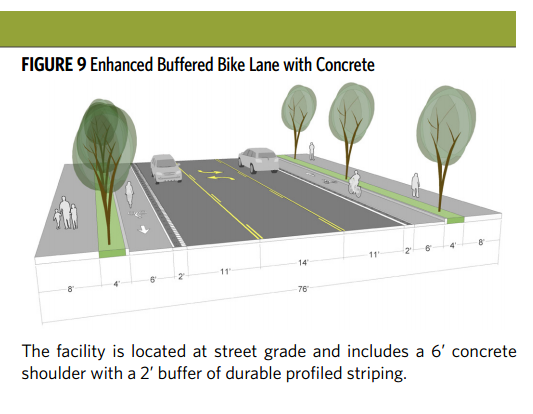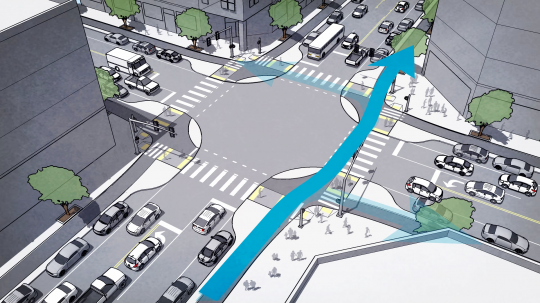
(Image: ODOT)
After an advisory group agreed that it wanted an upcoming rebuild of outer Powell Boulevard to include raised bike lanes, the Oregon Department of Transportation says they’re not practical after all.
“[A raised bike lane] presents a long list of challenges.”
— Matt Freitag, ODOT project manager
Among the issues the agency has cited were difficulty getting water to run off the pavement and into drainage areas; the number of driveway crossings; and the difficulty of sweeping debris or snow from the bike lanes, which would be narrower than any of the equipment the agency currently owns.
“Each of their own wasn’t a dealbreaker, but taken in aggregate [a raised bike lane] presents a long list of challenges,” said Matt Freitag, an engineer and project manager for ODOT’s Portland regional office.
Instead, Freitag said, the agency’s “preferred alternative” for Powell between Interstate 205 and 172nd Avenue is what it calls a “buffered bike lane.” But Freitag and project manager Mike Mason said that the “buffer” along Powell might be built with a different-colored material from asphalt and/or might include some sort of non-curb vertical separators.
A February memo that summarized options for Powell illustrated the “buffered bike lane” option as including “durable profiled striping,” which ODOT has described elsewhere as thick enough to give “auditory signals” to people when they drive over it.
Freitag and Mason said Wednesday the project is mostly done discussing whether or not there will be a raised or buffered lane.
“What’s undecided is what gets in the buffer,” Mason said. “Is it profiled striping, that raised striping that creates a vibration when you go over it, or some other type of raised pavement markers?”
Potter and Grosjean: ODOT tried its best to make separation possible
In interviews, two members of the advisory committee who had previously expressed support for protected bike lanes on Powell said they’ve been persuaded that raised bike lanes aren’t worth the cost on the street, which gets unusually heavy runoff from nearby hills during rainstorms.
“They really went into it trying to figure out how to get enough drainage,” said Cora Potter, a frequent bike user who sits on the Outer Powell Safety Project’s Community Advisory Committee. “Anything that involves grade separation greatly increases, like quadruples, the cost. … If you have a curb, you basically get a puddle at the curb that then comes in and covers up the bike lane. If you don’t have a curb, it just flows off the bike lane in a sheet.”
Paul Grosjean, the committee’s co-chair and a member of the Pleasant Valley Neighborhood Association, said that “after thinking about it for several months,” he’d decided a buffered bike lane would be fine.
“I have driven the entire corridor with just that in mind, and kind of looked at as I drove and said ‘What is this going to be like?'” He said. “I think this is the best solution that is available.”
Potter said she thinks there’s still a chance for the street to get domes like those used in Houston, Washington DC and elsewhere.
“The turtle dome things are actually kind of good, I think, if they’re spaced close enough together,” Potter said.
Potter also said she expects the bike lane to be very visually distinct. If it isn’t, she said, more people will drive in the bike lane to jump the queue for right turns, etc.
“The asphalt would be a different color or they’d make it out of concrete,” she said. “If they don’t, then I’ll be really disappointed. Because it needs to be visually very very clear that the bike lane is not a place for cars on Powell.”
Protected intersections might yet be included

A rendering of a protected intersection included in ODOT’s memo for possible intersection treatments on Powell, for example at 122nd Avenue.
(Image: Nick Falbo)
Elizabeth Quiroz, a professional advocate for the Bicycle Transportation Alliance who sits on the advisory committee, said in a July 12 email she doesn’t like the new plan.
“Many community members are not happy with the final option presented by ODOT.”
— Elizabeth Quiroz, BTA
“Many community members are not happy with the final option presented by ODOT,” she said in an email. “Our understanding was that a raised bike lane was a top priority. … We expected better and safer infrastructure.”
Mason and Freitag said that none of the issues ODOT identified with a raised or otherwise protected bike lane were insurmountable.
The City of Portland might be able to get a narrower street sweeper. Higher-grade crossings and driveways might prevent the “up and down” bobbing that they fear a raised bike lane might give people biking. Even the drainage issues might be solved with enough money.
They and Potter, the advisory committee member, also said there’s still potential for greatly improving the signalized intersections at 122nd and 136th with Dutch-inspired elements like bend-out bike crossings and corner safety islands to force sharper turns.
“The intersections are what really scare me,” Potter said. “As a bike rider, my honest opinion is if they can do the treatment that makes it obvious it’s a bike lane, like a different surface, and then plow as much money as they can into the intersection treatment, as someone who will probably ride a bike there, that’s what I would do.”
Freitag said protected intersection designs are possible at the signalized intersections.
“We’re certainly looking at options that include those elements,” he said.
Mason said that whatever happens on Powell, it’s going to be settled quickly — at least for the stretch from 122nd to 136th where reconstruction was already funded by the state legislature.
“The discussions with the city should happen over the next couple of months if not sooner,” he said. “We’re on a fast track to get this designed and built, so we need to be making decisions.”
— Michael Andersen, (503) 333-7824 – michael@bikeportland.org
Our work is supported by subscribers. Please become one today.
The post State says raised bike lanes won’t work on outer Powell appeared first on BikePortland.org.
from Front Page – BikePortland.org http://ift.tt/2agoY7y


No comments:
Post a Comment